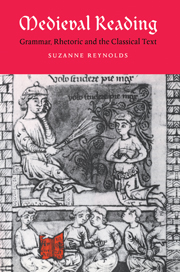Book contents
- Frontmatter
- Contents
- Acknowledgments
- Abbreviations
- 1 Introduction
- Part I CONTEXTS FOR READING
- Part II READING PRACTICE
- 4 Origins and mythologies: the invention of language and meaning
- 5 Reading word by word 1: the role of the vernacular
- 6 Reading word by word 2: grammatical and rhetorical approaches
- 7 From words to the phrase: the problem of syntax
- 8 Government: the theory and practice of a grammatical concept
- 9 Rival orders of syntax: vernacular, natural and artificial
- 10 From the phrase to the text: grammatical and rhetorical approaches again
- 11 Naked intention: satire and a new kind of literal reading
- 12 Literacy: a new model for the classical text in the Middle Ages?
- Notes
- Select bibliography
- General index
- Index of manuscripts
- Cambridge Studies in Medieval Literature
10 - From the phrase to the text: grammatical and rhetorical approaches again
from Part II - READING PRACTICE
Published online by Cambridge University Press: 22 September 2009
- Frontmatter
- Contents
- Acknowledgments
- Abbreviations
- 1 Introduction
- Part I CONTEXTS FOR READING
- Part II READING PRACTICE
- 4 Origins and mythologies: the invention of language and meaning
- 5 Reading word by word 1: the role of the vernacular
- 6 Reading word by word 2: grammatical and rhetorical approaches
- 7 From words to the phrase: the problem of syntax
- 8 Government: the theory and practice of a grammatical concept
- 9 Rival orders of syntax: vernacular, natural and artificial
- 10 From the phrase to the text: grammatical and rhetorical approaches again
- 11 Naked intention: satire and a new kind of literal reading
- 12 Literacy: a new model for the classical text in the Middle Ages?
- Notes
- Select bibliography
- General index
- Index of manuscripts
- Cambridge Studies in Medieval Literature
Summary
Schemata lexeos sunt et dianoeas, id est figurae verborum et sensuum. sed schemata dianoeas ad oratores pertinent, ad grammaticos lexeos.
There are schemata lexeos and schemata dianoeas, that is to say figures of speech and figures of thought. But the figures of thought belong to the rhetoricians, the figures of speech to the grammarians.
Donatus, BarbarismusIf the text's periodic syntax was seen as something to be combated, even ‘naturalised’ by exposition, we might expect a similarly adversarial approach from glosses which treat other elements of the text's style. However, this is far from the case. When glossators come to look at figurative language, which is defined precisely by its departure from the norms of grammatical correctness, the text becomes a resource, an embodiment of the strategies of elocutio with which the student must be acquainted. This shift in attitude derives ultimately from grammatica's traditional claim to the figures and tropes, the foundations of elocutio, a claim which in turn derives from the ancient practice of textual enarratio that I sketched in the second chapter of this book. But, as we saw there, the claims of rhetoric are also pressing, and it will be the principle aim of this chapter to show how the practice of glossing the figures and tropes in the classical text forces us to reassess where and how we place the boundary between grammar and rhetoric in the twelfth century, and even whether, in reading practice, the notion of a boundary is sustainable.
- Type
- Chapter
- Information
- Medieval ReadingGrammar, Rhetoric and the Classical Text, pp. 121 - 134Publisher: Cambridge University PressPrint publication year: 1996



